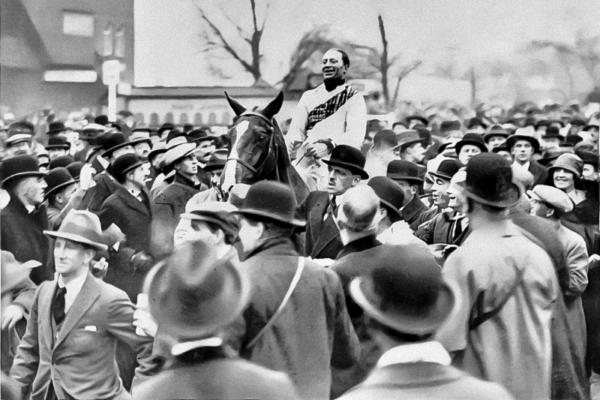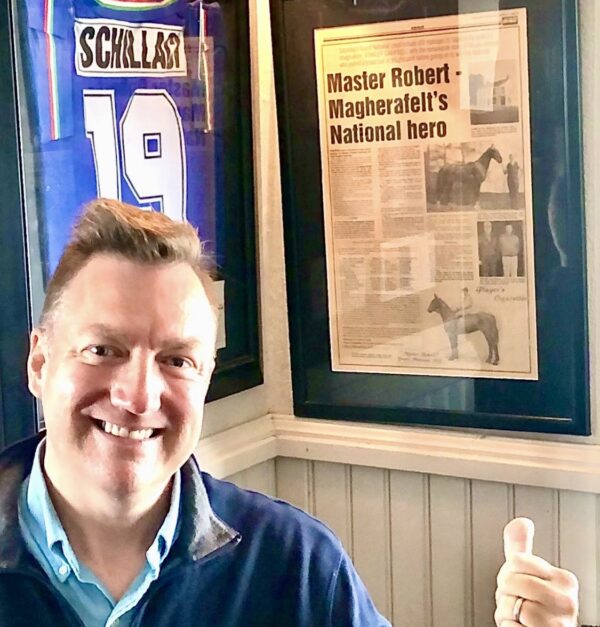
Master Robert entering the winner’s circle in 1924 with jockey Bob Trudgill, being led by Lord Airlie, with Aubrey Hastings to the right smiling. From the collection of Francis X. Murray. Used with permission.
‘Master Robert’, was born, bred and trained just a few miles outside the border town of Castlefin.
The thoroughbred was raised by Mr Robert McKinlay on his farm at Sessiaghmore, on the back road between Castlefinn and Convoy. When not on the racing, he was used to plough McKinlay’s land, hence the nickname ‘plough horse.’
According to his grandson, Mr Terence McKinlay, Master Robert’s sire (father) was called ‘Moorside II’ and his dam (mother) was called ‘Dodds’, acquired from Robert Patterson of Manorcunningham.
When the foal was born he was an “enormous size” and, when he was two years-old, he was sent to The Curragh to be trained by Mr Maurice Reidy.
However, Mr Reidy wrote to Mr McKinlay to say the horse was “too much overgrown” and although fast, he could not compete with the other horses of the same age.
Mr Reidy advised that the horse be taken back to Castlefin and to make a “chaser of him.” Master Robert was trained as a ‘chaser’ by a Mr Anthony in 1919, however, he was returned to Mr McKinlay again as he was deemed to be “no good.”
He also refused to work in chains on the farm and was subsequently sold to Mr JT Elliott of Strabane for £50. Mr Elliott kept him for around six weeks and, part of that time, he was at grass in a field next to the Donegal Railway line.
“One day, when a train was passing, he took fright, jumped the gates onto the line and galloped along the railway track for about two miles in front of the engine,” Mr McKinlay said.
Master Robert was sold several times, including to Magherafelt publican, Paddy Murray. Mr Murray kept the horse at his pub (now called Bryson’s) before he sold it on.
He was then purchased by Mr HJ Fordham of Royston, Hertfordshire in England in October, 1921. Mr Fordham won a number of races with him before selling him on to Major Sidney Green and, finally, to Lord Airlie.
Now, a New York based Irish-American writer, Fran Murray, is planning to turn the story of Master Robert into a nonfiction novel. Mr Murray, who runs the website www.masterrobert.horse, spoke to Derry Daily this week.

Master Robert entering the winner’s circle in 1924 with jockey Bob Trudgill, being led by Lord Airlie, with Aubrey Hastings to the right smiling. From the collection of Francis X. Murray. Used with permission.
Until ten years ago, Mr Murray said he possessed an insignificant knowledge of his Irish heritage.
“On my first trip to Ireland in 2013, through a series of serendipitous events, I met a third cousin of mine, previously unknown to me, during a visit to County Derry,” he explained.
After spending a pleasant few days with my newly-discovered relative – learning much about my paternal County Derry heritage – he asked me on my way out of his door: ‘Do you know the story of Master Robert?’.”
His cousin subsequently told him that Master Robert won the 1924 Grand National, which he knew to be the world’s most significant steeplechase competition.
“He explained to me that his uncle, Patrick Murray (my great granduncle), owned the horse for a time before he won, and that he kept the horse at the local pub he owned which still exists. He told me I should stop by on my way out of town. Wow, I thought; That’s pretty cool.
“So I did indeed visit Paddy Murray’s old pub on my way out of town.”

Fran Murray at Bryson’s pub in Magherafelt
According to British Pathé, a world-record 45 cameramen filmed the event, representing a milestone in the evolution of live event filming.
A British Pathé silent film of the race can be found online here: https://bit.ly/1924GrandNational
To find out more about Mr Murray’s upcoming novel, and to contact him, go to: www.masterrobert.horse
Tags:




